Return to table of contents
American Canoe Association
Cruising class sailing:
100 year history 1907-2006
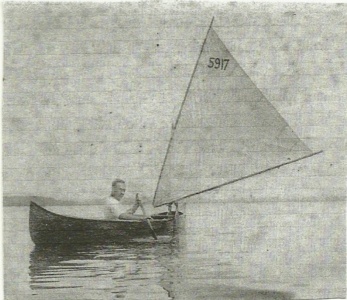 I have always been curious about the origins and history of the CRUISING CLASS of
sailing canoe. So now as we approach the hundredth anniversary of the two major trophies
for this kind of racing, I decided to investigate further. The first competitions for the
Cruising Trophy at the national level at Sugar Island and the Lady Bug Trophy at the
Atlantic Division Regatta were held in 1907 and have continued ever since. What happened
in 1907? What was going on in 1906? How had sailing the open canoe developed?
I have always been curious about the origins and history of the CRUISING CLASS of
sailing canoe. So now as we approach the hundredth anniversary of the two major trophies
for this kind of racing, I decided to investigate further. The first competitions for the
Cruising Trophy at the national level at Sugar Island and the Lady Bug Trophy at the
Atlantic Division Regatta were held in 1907 and have continued ever since. What happened
in 1907? What was going on in 1906? How had sailing the open canoe developed?
People smile when I say the American Canoe Association was founded by a group of
cruising, sailing kayakers and sometimes laugh out loud when I call the International Ten
Meter Sailing Canoe the Sailing Kayak. In North American English, they are both correct. So
I was happy to find these quotes in Outdoor Magazine in 1889 by C. Boyer Vaux, first winner
of the Sailing Trophy.
In his discussion of "The Evolution of Canoeing", he says, "Civilized canoeing has
been progressing in two distinct and parallel lines. (1) The evolution from the dug-out and
Indian birch is the canoe now used in Canada. In model it has few varieties, closely
connected, but the main evolution of late years has been in construction. The single blade is
practically used entirely; and the kneeling position,- sometimes varied by the sitting posture
on high seats often across the gunwales,-differs greatly from the position the paddler takes
when using the double blade. These canoes rarely carry sail and the double blade has been
used but little,-principally in racing. (2) The kayak of the Esquimaux gave the idea of a
decked canoe to the civilized canoeist; and this canoe became generally known when
Macgregor wrote it up. A double paddle is always used, the paddler sitting quite low down in
the well and leaning against a backboard hung from the deck."
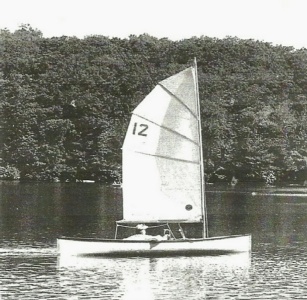 And later he writes, "The canoe carrying sail is derived from the kayak, through the
Rob Roy, to and beyond the Nautilus No.3. It has no connection with the birch and is
independent of it."
And later he writes, "The canoe carrying sail is derived from the kayak, through the
Rob Roy, to and beyond the Nautilus No.3. It has no connection with the birch and is
independent of it."
In the winter of 1906 -- 1907 the two most important trophies of what is now known
as "The Cruising Class" were established, officially designating this as a sailing class of the
American Canoe Association, and this class has been contested ever since. The first of these
trophies was the "Lady Bug Trophy", given to the Atlantic Division as the Atlantic Division
Championship by A. M. Poole, whose canoe was the Lady Bug. The deed of gift has been
attached to this article. The other trophy was "The Open Canoe SailingTrophy", for which a
collection was taken, and was designated to be raced at the National Encampment and was
therefore, in effect, the National Championship.
So what happened between 1879 and 1906 that "civilized" these open canoes that were
descended, at least in general shape, from the birch bark of the Indian?
In the Rice lake region of Ontario, in 1858, I.S. Stephenson developed and built
canoes of basswood in the general shape of the birch bark canoe but built of lightweight strip
planking and narrow ribs tacked and screwed together in the European boat building style. This
was followed by the establishment of several companies which became the Peterborough,
William English, Rice Lake and others, making this type of canoe. These canoes became the
most used canoes in paddling racing in Canada and the United States and continued as such
until the Second World War.
The American Canoe Association held an Annual Encampment every year after its
founding at Lake George in 1880. Many of the early encampments were in southern Ontario,
including the Thousand Island region of the Saint Lawrence River. As usual, when sportsmen
get together they start to set up various forms of competition and so contests in sailing,
paddling, tilting, overturning and emptying and other ways of handling canoes were initiated.
The first Championship officially recognized was the ACA Record in l884. This was a three-
race series of one sailing race, one paddling race and one combined race with six alternating
paddling and sailing legs, recognizing, in other words, the best "all around" canoeist!
At these Encampments they became acquainted with the Peterborough type of canoe
used by the Canadian Members and photographs of these encampments show the predominant
number of these canoes on the beach and in the water as these canoes became used in the
paddling races.
So, by the time the ACA bought Sugar Island in 1901 and held its first National
Encampment there in 1903, these were the circumstances that led to the establishment of
Open Canoe sailing and its recognition as a class which we now know as the Cruising Class,
so named because the canoes were, and are, used for camping trips or, "cruises" under paddle
and sail.
There was an annual National Encampment of the ACA at which various paddling,
sailing and tilting and other competitions wee held and Divisional Encampments at which the
same competitions were held.
The "Sailing Canoes" which were decked, had centerboards, sliding seats and tall rigs,
were principally made by Rushton, Stevens or were imported from England. At the 1903
Encampment at Sugar Island they were from the Winchester Boat club on Mystic Lake near
Boston (which is still there where I currently do most of my sailing), from the New York
Canoe Club on Eastchester Bay, Long Island Sound, and the Knickerbocker Canoe Club on the
Hudson River. They had National Trophies, which dated from 1884, and some Divisional
Trophies.
Many of the attenders of these meets owned Peterborough type open canoes in which
they cruised and raced paddling. At least one of the Canadian builders made and sold simple
lateen sailing rigs for them.
There was a standard set of measurement rules which were made for paddling. This
provided a group of very similar canoes. It also provided a basis upon which a set of "Open
Canoe" Sailing Rules were established.
By the time of the first encampment at Sugar Island in 1903 there was a set of "Racing
Regulations" for sailing open canoes which was essentially what we have today except the
sail area was 60 square feet for any size canoe. An "Open Canoe" sailing race was also held
with four of the contestants from the New York Canoe Club and one from Park Island Canoe
Club at Trenton, New Jersey. Two of these sailors also raced in Sailing Canoes.
At Sugar Island in 1905, Open Canoe races were held with seven contestants, two of
whom also raced in Sailing Canoes. They were from the New York Canoe Club, the
Knickerbocker Canoe Club and the Admiralty Cub of Ithaca, New York.
In the Next year there was an expansion of the fleet so that at the next National
Encampment at Sugar Island in 1906 there were sixteen contestants in the Open Canoe sailing
race. Fifteen sailors raced in Sailing Canoes with four racing in both and the two new trophies
were established for 1907.
The first race for the Lady Bug Trophy was held on Saturday, May 30, 1907. There
were seven starters, the race was two miles, the wind was strong and the water rough and the
race was won by A.M. Poole of the New York Canoe Club (who had donated the Lady Bug
Trophy) in his canoe "Lady Bug", with H.D. Cochrane of the Knickerbocker Canoe Club 2nd.
The first contest for the "Open Canoe Sailing Trophy" was a series of three races held
at Sugar Island in August 1907, in which twelve open canoe sailors competed, nine of whom
also competed in decked sailing canoes. The races were three times around a triangular course
with essentially the same rules that we now have but with a maximum sail area of 40 square
feet.
Who were these sailors? They were generally young, affluent men with high-class
addresses in New York City, or elsewhere, who were active in the ACA administration and
who cruised and raced in sailing, paddling and tilting competitions. In these first few years,
they were mostly from the New York area. The winner of the Trophy at Sugar Island, George
P. Douglas, was the National Commodore of the ACA, a Member of the Knickerbocker Canoe
Club in the Hudson at Fort Washington, who sailed a decked canoe and won paddling races.
He lived in Newark, New Jersey. The three races were closely contested with Austin M.
Poole, who also was now a Knickerbocker, and sailed a decked canoe and raced in paddling
races. He was the one who donated the "Lady Bug" Trophy to the Atlantic Division. (His
address was 36 Wall Street, New York City.) The Atlantic Division sailors were joined at
Sugar by Herman Dudley Murphy of Winchester, Massachusetts and W.G. Sparrow of
Toronto.
These men were in the prime of their racing careers. In addition to George Douglas,
E.V. Walker with De Camp, in 1907 won the 2-man double blade paddling race at the Atlantic
Division and at Sugar Island, won the 1-man single blade and 2-man single blade, 2-man
double blade and the Mixed Tandem paddling races. In 1908, E.V. Walker won the Lady Bug
and the 2-man single blade at the Atlantic Division, and at Sugar also won the ACA record,
single blade race and raced a decked as well as open sailing canoe.
Farnham Dorsey is of particular interest to me because I have a cruising canoe in
which he said he won the trophy, and which I have raced (in his honor) with original rigging.
In 1901 he won the Challenge decked canoe championship, sailing from the Winchester Boat
Club with Dudley Murphy in the Eastern Division. In 1908, he was sailing with the
Knickerbocker Canoe Club (also with a prominent New York City address), won an Atlantic
Division paddling race and at Sugar raced a decked sailing canoe, was third in the ACA
Record, second in the Open Sailing Trophy and won two of his tilting matches. In 1909, he
was listed in the Atlantic Division and Knickerbocker C.C. but with a prominent Rochester
address. At Sugar, he won the Open Sailing Trophy for the first time, was 3rd in the Record,
winning the sailing race, was third in the decked sailing championship, was second in the
Tilting and paddled in a race with Dudley Murphy of the Eastern Division. He won the Open
Sailing Trophy in 1910 and 1913, and in 1915 was listed in the Central Division but gave a
Boston address and was, at Sugar, 3rd in the Record, 3rd in the Open Sailing Trophy and second
in the race around the Island. By 1923 he was living in Rochester and must have known me as
a baby on Sugar Island but was not competing.
Up to the First World War there was little change at Sugar Island but new sailors
entered the group in the Atlantic Division and, although except for Fred Wolters, they did not
enter races at Sugar, won the Lady Bug trophy at the divisional meets. Fred Wolters, Doug
Cummings and my uncle Jule Marshall later went on to win national honors.
During this period, although many open canoe sailors were close contenders, only
George Douglas, E.V. Walker, G.F. Henshaw, Doug Cummings and Fred Wolters had enough
skill with the paddle to win the ACA Record combined sailing and paddling trophy. However,
from 1907 to 1916, they won eight of the nine competitions. Decked Sailor Dudley Murphy
won the other. Murphy had raced in the open sailing before.
My father, Thomas Zuk and my uncle, Jule Marshall, both joined the ACA in 1909;
Tom in the Fort Washington Canoe Club and Jule in the Inwood Canoe Club, near one another
on the Hudson River. They became friends and fierce competitors. Dad met my mother,
Grace, and Jule met his wife, my dad's sister Mae, at dances at the canoe club. In 1974, at an
ACA National Meeting in Michigan, when I was elected Commodore (25 years after my
father), I met a man from the Midwest, who, upon hearing my name, said, "In the old days, it
wasn't a sailing race unless Tom Zuk and Jule Marshall were in it!" Both were fine paddling
racers and raced in various classes for their clubs. In a short time, Tom became the one-man
double-blade champion of the river, so The Associated Canoe Clubs of the Hudson paid his
way to Sugar Island to win the coveted Paddling Trophy from the Canadians -- who had
dominated it for a while. In 1913, he did, winning the one-mile, one-man double-blade
championship race "Paddling Trophy". But he never racing in that event again, although he
raced in other events for his club. Jule, although a fine paddler and seems to have started
sailing before Dad, won the Lady Bug in 1915 and 1916.
Most of these canoeists used their canoes for day paddling, ‘girling’, and paddling-
sailing camping trips, so the rules and the rigs changed very little. Essentially the rules were
the same as we now have, with a 40 square foot, variable, sail area limit. The rigs were truly
hoisting and lowering and mostly lateen. Dorsey developed a rig (which I have) where the
whole mast tips back and lies on the canoe.
There were no races in 1917 and 1918 because of World War I. My father, Tom Zuk,
came back from the Army in 1919 and started sailing. In 1920 he won the Lady Bug and the
Open Canoe Trophy at Sugar. Then in 1921 he won the Open Canoe Sailing at Sugar and the
AC A Record (Admiralty Trophy) combined paddling and sailing.
In 1921, Dudley Cashmore, of Orange, New Jersey and the Knickerbocker C.C. and
Adam Whal, of the Atlantic Division appeared on the scene winning the Lady Bug and the
Cruising trophy and Adam won the ACA Record until 1924. I can remember Adam who was
a good designer as well as decked canoe sailor. By 1924, Tom Zuk had won three of the
major trophies, the only sailor to ever win the Paddling Trophy and, in his usual style, was on
to the next, trying to win the last one -- the decked sailing Challenge Trophy. He was sailing
with the decked sailors at City Island, New York.
Most of the races for the Lady Bug were held in the Hudson at George's Island and
later near the canoe clubs at Fort Washington and Edgewater, New Jersey. Competition was
active as Douglas Cummings Sr. of Connecticut won the Lady Bug in 1924 and several
sailors, including "Wally" Clausen (founder of the Red Cross Small Craft and Canoeing
programs), Fred Blake and Frank Baldwin. But the sailing started shifting to City Island
where the decked sailors had settled, and Walter Schalle and Barney Maltz won the Lady
Bug. My father was sailing a decked Canoe at City Island and coaching their paddling team,
and I was a little kid running around Ratlif’s on weekends.
At Sugar Island from 1924 through 1929, a different group was sailing open canoes as
Coggin, Denhard and Esselborn won the Open Canoe Sailing Trophy, Gordon Douglas and
Fred Wolters won the Admiralty from 1924 to 1929, except 1928. In 1928 my Uncle Jule
Marshall moved back East from the Midwest and lived across the street. He won the Open
Canoe Sailing Trophy at Sugar Island, then the Lady Bug on the Hudson 1931, 1932 and
1933; and also the Admiralty at Sugar in 1930 and 1931. He was a fine sailor and paddler. In
1935, my Dad built a house for him in Larchmont and he started sailing a Star, only
occasionally sailing a canoe with us.
In 1930, Barney Maltz from City Island won both the Lady Bug at City Island and the
Trophy at Sugar Island. He is one of the first sailors I can really remember other than Dad and
Uncle Jule, although later on, I could remember Adam Wahl, Walter Scalle, Frank Baldwin
and Fred Wolters.
During the period from 1934 through 1941, as we all struggled to recover from the
depression, the Cruising Class fell upon hard times. There was almost no sailing on the Hudson
River as the Decked Canoe Sailors moved to City Island. Hans Waldinger took over, winning
the Ladybug Trophy every year and the Open Canoe Sailing and the Admiralty at Sugar
Island for most of those years.
In 1935, my father sufficiently recovered financially and decided that he had better get
his son, at age 12, started sailing. (I had already won boys and girls paddling races at Sugar
Island in 1934.) He had read about and seen the Willetts 17 foot canoe and thought it would
sail well. So he got one and designed a new rig with an arm on the mast so that the lateen sail
would not rub on the mast on one side. He obtained a tent platform at the Atlantic Division
Camp at Lake Sebago and we started going there. During the next few years he and Hans
Waldinger managed to get together and hold the Lady Bug races. I remember in 1937 or 1938
at the Von Dohlin boat house at Edgewater on the Hudson, when I tied up in a canoe on a pole
in the river and ran the races for the two of them. Up and down, up and down, in the swells.
Boy! Did I get seasick? Hans was the finest paddle steering canoe sailor I ever saw!
Meanwhile, at Sebago, my Dad formed a group and, steering with a paddle, we held
handicapped sailing races in the seven canoes we managed to rig, exchanging canoes for each
race throughout the summer. I remember winning my first canoe sailing race in George
Bonnigton's 18 foot White Maine Guide Model. We sailed there until 1940 when I went to
College and the Navy. This sowed the seeds for Sailing racing at Sebego, which has been the
center of the Cruising Class ever since.
During this period of the late 1930's to World War II in 1941, Hans Waldinger
dominated the racing, winning the Lady Bug, the Cruising Trophy at Sugar and the new
"National Championship" for which Roger Wilkinson donated a Trophy in 1958. Hans was
born in Germany and played a guitar, which he had modified to be much like a lute. He sang
old German songs with great gusto. He and I played and sang many times together at Camp
Sebago and at Sugar Island the last at Dusty's Cabin probably in the 90's. During the late
1930's the Lady Bug and the National Championship were raced at City Island. Martin
Mayer and young Allen Mayer of Annapolis did each win one year at Sugar.
The Cruising Class has had a series of sailors who dominated the class for a number of
years, which in my estimation, discourages competition. We have already seen George
Douglas and then Farnham Dorsey in the beginning, then Jule Marshall and Hans Waldinger.
My father, Tom Zuk, on the other hand, would win a trophy and then go on sailing decked
canoes or something else and then come back. We have seen him win in 1920, 1921 and 1923,
then design a new rig and come back to give Hans some tough competition from 1937 to 1941
and we will see his winning again in 1947.
By 1932, Dad was the official measurer and I became his assistant. I have his
notebooks with the old measurements. At some point, in the 1920's, the sail area rule was
changed from the original 40 square feet to the present rule. At the present time, the area is
determined by the width and length of the canoe, increasing the area for wider canoes and
decreasing for longer canoes. The canoes used were the same old Peterborough Model 20 and
William English Model 16 and now the Willetts, sailed by the Zuks, Steve Lysak, Jesse
Mossberg and perhaps others.
There were no competitions from 1942 through 1945 because of World War II. After
the war we entered a new era in all of canoeing. People acquired cars as soon as possible and
carried their canoes to many new places. The clubhouses -- where the canoes were kept and
people gathered for social reasons and for competition or just a day on the water -- started to
close or become boathouses used mostly by dinghy sailors or motor-boaters. The new
canoeists carried their boats to wilderness cruises or river runs or competitions. White water
cruising and racing gained in popularity. Small sailing dinghies were available and more
affordable in large quantities. Correspondingly, new canoes were developed, including the
aluminum canoe and later reinforced plastic (fiberglass and related) canoes. The "old time"
scene changed rapidly. Sugar Island became less important as competitions were organized in
many locations. Canoe sailing was more affected than other canoe disciplines.
For a while from 1946, the center of canoe sailing remained at City Island with a
strong fleet of decked sailing canoes. I had just come home from the Navy that summer so in
September Dad put me in the Willetts to race the National Championship. In that year I was
4th to Hans Waldinger and Doug Cummings for my first appearance in national results, and in
1947, I was 2nd to Doug Cummings Jr. I can still remember the one big heavy race when I
capsized and shook out the canoe three times and finished 2nd. Doug Cummings Jr. won that
series to start his winning streak. Tom Zuk won the Lady Bug in 1947 but from 1947, Doug
Cummings Jr. won just about whenever he raced. He won the Lady Bug in 1950, the Cruising
Trophy at Sugar in 1947, 1948 and 1949 and the National Championship every year from
1947 through 1953.
Since the beginnings of cruising sailing at Sebago in 1936, as previously mentioned,
the canoeists there had been rigging some canoes and in 1948, or shortly before, Roger
Wilkinson rejuvenated the racing at the Atlantic Division Camp at Lake Sebago where it has
been the center of the Cruising Class ever since. Roger was a fine sailor, designer and
technician who was a leader in the Canvas Canoe Sailing of the Associated Canoe Clubs of
Sheepshead Bay. He was interested in using a sailing rig which had a small mainsail for the
Cruising Class to which he added a jib and rudder for the Class-C. For this he needed to
persuade the officials that a Marconi style sail, which could be hoisted up and down, satisfied
the rule that a canoe must have a hoisting and lowering "rig". Since the original intention of
the class was to use your canoe for paddling and sailing cruising with a camp outfit in the
canoe, a thirteen foot standing mast did not meet the intent of this rule and since the rule said
"rig", not sail, it did not fit the language of the rule either. For some reason, and with some
political influence, the interpretation of the rule was changed. I do not know the details and
would be happy to hear from anyone who has more information on the subject. I was racing
Whitewater canoes and kayaks in Colorado but I know my father, the National Measurer, was
vehemently against the change!
In 1948 on Labor Day Weekend, the National Cruising class Championship was held
at Lake Sebago, starting a tradition that has continued to this day at the completion of 100
years of the Class. There were sixteen sailors in the series and so many are well-remembered
for their own sailing, and/or have sons and daughters racing now, that I consider it worth
listing them. Doug Cummings Jr. was first and his father Doug Sr. second with Wilkinson
third and the others in order of finish: Al Loomis, Horace Freeman, Eddie Brans, Helen
Loomis and Carla Ungar, Ambrose Maushart, Joe Klecka, Leo Polt, Joe Delahunt, Jack
Remignanti, R. Sander, Fred Uebel and A. Kulakowich. Doug Cummings and Roger
Wilkinson fought it out at Sebago through 1953 with Wilkinson winning most of the Lady
Bugs and Cummings winning the Nationals.
Cummings also won the Trophy at Sugar Island in 1947 and 1948. In 1950 and 51,
however, there was less competition at Sugar Island and in 1951, Lysak first appears in
sailing results where he was 3rd in the Trophy which was won by Leo Polt with my brother,
Tom Zuk Jr., 2nd in both the Sailing and the ACA Record Combined! — the third Zuk in the
record book. Tom Zuk Sr. was busy being the Commodore of the ACA and a Member of the
overall US Olympic Committee.
Steve Lysak started winning with the Nationals in 1954 and he and Roger Wilkinson
alternately won the Lady bug and the Nationals at Lake Sebago from 1954 until 1967
although they did not always both race. Lysak dominated at Sugar Island from 1952 through
1964, winning the Trophy every time except in 1956 when my father, Tom Zuk, beat him in
that famous last race of the series in a heavy wind. Remember, Tom had won that trophy the
first time 37 years earlier in 1920!
The first 50 years of the two Trophies and the "Cruising" Class had now been
completed and the National Championship, "Wilkinson" Trophy had been added. The sailors,
except for Wilkinson, had been canoeists who were actively, or who had been paddling racers
who also went on camping trips sailing and paddling their canoes. The canoes were stock
model, predominately wood canoes from the Peterborough area, but a few canvas canoes at
Sebago. The rules had not changed much since the variable sail area had been introduced in
the 1920's except for the interpretation that a tall mast was allowed and only the sail, not the
rig, had to be hoisting and lowering. Different rigs had been tried but the only ones which
were still being used were the original Lady Bug lateen, Tom Zuk's modified lateen with an
arm on the mast, Lysak's bent gaff gunther type and now the new tall Marconi, usually with a
full battened sail. The center of sailing still continued at Sugar Island but the Lady Bug and
National Championship had moved from the Hudson River to City Island to Lake Sebago.
Sebago is a wonderful place for sailing because the group of canoeing paddlers and
campers who own canoes is there all the time, permitting frequent scheduling of races. Also,
the lake has reasonably good, if changeable, sailing conditions with no motor boats and little
other boat traffic and, most of all, ACA members who have taken leadership roles in helping
rig canoes and conducting the races. The camp maintained its leadership for the next 50 years!
In 1968, Joe Klecka, former paddling racer and camper at Sebago and Sugar, started
winning with the Cruising Trophy at Sugar Island and the Lady Bug and the Nationals at
Sebago and continued this dominance through 1977. Gordon Miller was also a paddler and
camper at Sebago and rigged a Mohawk Ranger canoe which is still winning races today with
its third owner! He started his winning streak with the Nationals in 1976 and both the
Nationals and the Lady Bug in 1978. Leo Polt and Al Loomis won the Lady Bug in 1972 and
1975 but, for the most part, Joe Klecka and Al Gordon Miller fought it out with Miller wining
most frequently until 1985. The Sebago fleet was prospering with enjoyable competition
except Miller and Klecka kept winning all the time. But the others had competitions with each
other. In 1970, when I returned East, there were 21 canoes in the Nationals.
In 1970, I returned from winning white-water championships in Colorado, where I’d
been racing Dave Fishman's old 1953 decked sailing canoe in one-of-a-kind sailing races and
starting a small fleet of six sailing canoes in Denver. I went to Sugar Island and sailed but did
not race. I then restored the 1936 Willetts, which my Dad had been racing and that I had
learned to sail in, and with its original rigging and sail, started cruising racing in New
England. In 1972, I went to Sugar Island and got a second in the race around the Island for
my first real canoe sailing race since the Nationals at City Island in 1947! That Labor Day I
went to Sebago and resumed sailing there. There were 12 canoes in the series where I was 3rd
to Joe Klecka and Joe Ryan. In 1973 it was similar. Leo Polt won the Lady Bug and I was
back in the pack; at Sugar it was Klecka, Ryan, Zuk, and at the Nationals at Sebago we had
17 canoes racing with Klecka's winning again. This is probably when the picture was taken
with all the "old" Sebago sailors and Joe Klecka with the Trophy. Al Miller and I are the only
sailors still around, and I am the only one still racing although there are sons and daughters
now racing. Fred Uebel's two sons, Don and Tom, and his grandson are racing. Al Loomis'
daughter, Sherrie Winkworth and Joe Ryan's daughter, Joan Krilla, are racing.
Joe Klecka continued his winning ways through 1977. Lysak was sailing decked
canoes, Wikinson was sailing Class-C canoes in Rumson and Joe Ryan was giving him the
closest competition. Al Miller was progressing and I was racing the old canoe but busy being
the Commodore of the ACA, on the ICF Congress and an Olympic Official. Unfortunately, the
fleet of cruising canoes became smaller as older canoeists dropped out.
I realized that the old Willetts was not really competitive. So, in 1977, I finally got
time to design and build a new canoe specifically for cruising sailing. This was the first
major change in the canoes used in the Cruising Class. Before this, stock model canoes were
used which were designed, or just evolved, for paddling, girling, or other purposes. The canoes
used were selected by the "least bad" method. From all the canoes available these seemed to
be the best: the William English Model 16, the Peterborough Model 20, and the Willetts
from the old wood canoes, and the Mohawk Ranger fiberglass canoe, and were the favorites.
In 1977 and 1978 I designed and built the strip canoe of Sitka spruce with mahogany
gun'ils and trim I called the "Osprey", the first canoe designed specifically for open canoe
sailing. I got second to Miller that year at Sebago but did not go to Sugar where Bill Kopko
won the Trophy. But in 1979, while it was Miller - Zuk - Klecka at Sebago, I beat Al Miller
for the Cruising Trophy at Sugar Island — the third member of the family with his name on
the trophy. Then in 1980, Miller continued his winning ways at Sebago while at Sugar the
three of us battled it out in heavy winds. Although the smallest in the race, I won the first
and third triangular races, Klecka got two seconds but won the second, windward-leeward
race, and by the scoring system of that time, got extra points and got the Trophy even though
I beat the two of them two out of three races! Al Miller continued winning at Sebago and in
1981 and 1982 when he was at Sugar Island.
When I first met Joe Klecka at Sebago I was 12 years old and Joe was about 20. He
was one of the young men attracted to the Camp at Lake Sebago and then to the sport of canoe
paddling racing which was what we now call "sprint", Olympic Style racing. Joe was a New
York city Fireman, as so many Sebago paddlers are, and later became a Chief. Joe loved to
play the harmonica and lead the singing at the campfires which he did with much gusto! I was
learning to play the guitar at Sebago and the Boy Scouts. So, I learned and played all the old
Sebago songs which I still do. We played and sang later at Sugar Island and in his last few
years when campfires were a thing if the past, I made it a point to take my guitar and go to
Joe's cabin and we would play together. He loved it so! Joe was a big man, a good sailor and
a great competitor!
When Joe Klecka, Al Miller and I were competing at our best in the middle of the
Saint Lawrence River in 1979-1980, I was 56 years old, Joe was about 64 and Al 45. Joe was
the biggest at over 200 pounds, Al was in the middle and I was the smallest at 150 pounds.
Joe raced to about 75 years old, I am 84 and still racing and Al sailed large boats but, at 72, is
rigging a canoe to come back. Not bad for some old National Championship canoe paddlers!
In 1980, at the 100th Anniversary Class-C National regatta at Lake George, Ed Kartell
and I and our wives had a breakfast which had a great effect on Canoe sailing. We discussed
what we could do to increase participation (although 35 canoes raced in that regatta!) and as a
result Ed had Jensen design and Mohawk make a canoe for open sailing, which he called the
"Ultima". A year later, I designed and started producing a reasonably priced canoe sail and
rig, and established rules for the ACA Class sailing canoe. The sail was especially designed to
be eligible for the Cruising Class on most canoes. While the history of the ACA Class is a
different story, the class had two effects on the Cruising Class. It did help by providing
available, high quality rigs. Since 1983, I have raced in the Cruising Class in every regatta
with an ACA Class rig, steering with a paddle, and many others have used them. At Sebago
we have Cruising Class races with 4 or 5 ACA rigs out of 7 canoes and have had a regatta
with ACA Class, steering with a paddle.
On the other hand, in 1983 racing began in the ACA Class with Class-C sailors and
Cruising sailors joining in to make it very popular, so that at Sugar Island the schedule
became shorter and eventually the Cruising Races, with few contenders, were squeezed out.
In 1984 and 1985 I won the ACA Class Nationals and Sugar Island series and Miller was not
there, leaving Klecka with the Cruising Trophy. Al Miller had added a rudder to his canoe and
was winning the Class C Nationals!
Al Miller's dominance at Sebago in the Lady Bug and National Championships
continued through 1985. Then I won the Lady Bug in 1986 and the Nationals in 1987 and 1989
leaving the other races to Klecka. In 1985, Tom Uebel appeared with a second in the Lady
Bug and in 1986 with a 4th in the Nationals. He had been sailing at Sebago for several years
and then in 1988 Tom Uebel won the Lady Bug and the Nationals at Sebago for the first time!
I didn't race at Sebago that summer so he didn't get the pleasure of beating me. From 1989
through 1993, four to six canoes raced at Sebago. Klecka won some, I didn't sail there much,
winning the Lady Bug once, but Tom Uebel, Dave Winkworth and Sherrie Winkworth won
the Lady Bug and the Nationals, sometimes beating Klecka.
At Sugar Island the schedules had been shortened to only four days of racing, including
the race around the Island, and three race series for the Class-C and ACA classes. There was
not sufficient time nor were there enough sailors for the Cruising Class. Unfortunately, the
Cruising Trophy was not contested after 1987 or 1988.
From 1994 through 1996, I won the Lady Bug. But in the Nationals in 1995 and Lady
Bug in 1997, Alan Perault took over and won both through 1999. Alan came to Sebago
because his wife was the life guard at the dock. I met him at a pot luck supper and had a long
talk with him and others encouraged him to come try sailing. Someone loaned him a canoe
and in 1992 one evening I met him out on the lake by chance and gave him a few pointers on
paddle sailing. Others encouraged him and he bought Al Miller's Ranger which was a very fast
canoe which he sailed well. From 1995 in the Nationals and 1997 in the Lady Bug he
dominated the racing. I couldn't beat him with a 45 foot ACA Class sail on the Osprey, which
usually carries a 50 foot fully battened Marconi sail. The few times I beat him were in light
winds when I put on the tall Marconi rig. On the other hand, he never beat me in about 12
races in the ACA Class where we both had the same sail. Alan also branched out and did some
racing in the Class-C and ACA class races and was starting to do well. He was a good sailor!
Because of some problems with his hands he retired from racing.
In 1991, with Ted Van Dusen, I designed and we built the canoe which I had intended to
be the canoe for the ACA Class. I named it the "Dragonfly" after the emblem of my father’s
old Fort Washington Canoe Club, which we had on all of our canoes and equipment. It came
after ten years but proved itself in the Class-C and ACA classes by winning many National
Championships. I own the mold and let it be used by any ACA member. Ted molds the light
weight carbon fiber composite hulls. My 17'6" by 35.5" Dragonfly weighs 41 pounds. The
second Dragonfly was permanently decked at 59 pounds for rudder steering in the Class-C
and ACA Classes. I have raced only in the open Dragonfly with an ACA Class sail, steering
with a paddle, in every class since winning its first Trophy, the Lady Bug in 1992.
In 2000 and 2001, I won the Lady Bug and the Nationals. Like my father, Tom Zuk, I
do not think it is good to have one person dominating a class for a long period, which has
repeatedly happened in the Cruising Class. It stifles competition. Tom would win and then go
on to something else, so you will find his name in these trophies in 1920-23, in 1947, and in
1956 -- a period of 37 years. In a similar manner, I started canoe sailing racing in 1936 at
Sebago, then 2nd in the Nationals in 1946-47 and then back in 1972 to win the Trophy at Sugar
Island in 1979, and all three of the trophies several times until 2003. This was mixed in with
the ACA Record -- Admiralty Trophy -- at Sugar in l978 and the National Championships in
the ACA Class sailing. I purposely did not race many races, to encourage competition but I
have raced for 72 of the first 100 years of the Cruising Class.
In 2002 I decided to see how the old canoes would do in today's competition. The rules
were substantially the same except the rigs were truly hoisting and lowering. So in the Lady
Bug I sailed Farnham Dorsey's 1908 Peterborough which had won the Trophy at Sugar Island
several times from 1909 through 1913. I used the original rigging with a copy of the original
sail and the whole mast and sail tip back and store on the thwarts and can be easily hoisted and
lowered. The canoe did very well and I got a second in the Lady Bug to Don Uebel, long time
paddler and sailor at Sebago. Then in the National Championships, I raced my Dad's Willetts,
the canoe I had first learned to sail in 1935, 68 years earlier. I won the Nationals in the old
Willetts which, I found had never won that Trophy before!
In the early 2000's Mick Raffle started taking a leadership role and building up the
sailing at Sebago at which he has done a great job. In 2003, he asked me to come down and
give everyone some tips on paddle steering. It was refreshing since there were several
younger, developing sailors, like Mick and Dave Sherman, who continued to sail very well.
We started by sailing around the lake without any paddles or steering devices, and went on
from there. I also left my best Cruising Sailing canoe, Osprey, for them to use. Tom Uebel, a
fine sailor, who had won the Trophies in l988 and was returning after recovering from cancer
of the lung, borrowed the Osprey. So, although I won the Lady Bug, Tom won the Nationals
in 2003 and was off on a winning streak.
In the winter, I built and rigged Dragonfly number 8, with an ACA Class rig, for Tom
and he picked it up in April, 2004 at my house. At Sebago all summer it was Tom Uebel --
Larry Zuk. I won six individual races but he won all the series. Mick Raffle set up to run all
the open canoe Nationals at Sebago and Lake Tiorati, near camp. The Finns came to sail with
us. They had adopted the ACA Class as a National Class and brought their sails. We loaned
them canoes for all the races. Tom Uebel beat me for the Cruising Class National
Championship, with an ACA Class lateen sail. Then with the same Dragonfly, he went on to
win both the Class-C and ACA Class nationals, steering with a paddle! No one had ever won
the Class-C with a paddle and no one had ever won all three open canoe sailing classes, let
alone in the same year!
Mick Raffle was also improving and sailing very well in Al Miller's old Ranger. In 2005
he won both the Lady Bug and the National Championship at Sebago. Tom was still sailing the
Dragonfly with the ACA Class sail.
Over the winter I designed and we made a Marconi style cruising sail for the Dragonfly
and with Ted Van Dusen developed a carbon fiber mast to be available for all open canoe
sailors. In 2006, with the Marconi rig, Tom Uebel again won both the Lady Bug and the
Cruising Class National Championship at Lake Sebago.
One hundred years of competition of the "Cruising Class" as a recognized Class of
Sailing Canoe in the ACA has now been completed and we are preparing for the 100th
Anniversary of the Trophies in 2007. In general, what had transpired over the hundred years
and what had changed?
SUMMARY:
Activity: In 1906 at Sugar Island there were 16 Canoes racing and in 1907 there were 7
racing in the Lady Bug and there were three series of races at Sugar Island with 13
participants.
In 2006 there were 6 canoes in the Lady Bug and 7 in the Nationals but there was
no competition at Sugar Island. The two cruising canoe sailors who were there
sailed in the Class-C and ACA Class races. The most competitors that I have come
across in any major competition was 21 sailors in the Cruising Nationals at Lake
Sebago in 1972 and 35 sailors in the Class-C Nationals at the 100th Anniversary
Celebration at Lake George in 1980. In many years the Cruising Class competitions
had only two!
The canvas canoe classes A, B, and C were recognized by the ACA in 1935 and the
ACA Class, in which you can sail your cruising canoe with an ACA sail, was added
in l983 to the Open Canoe sailing, offering alternative classes for the sailing
canoeist.
Rules: The rules for the canoes and rigs in the Cruising Class have not materially
changed since around 1920 when the rule for the varying sail area based on the
length and width of the canoe was adopted. Before that the sail area was limited to
40 square feet.
I don't know of any canoe which qualified in 1907 that would not meet the class
rules today. In 2002, I got second in the Lady Bug in Farnham Dorsey's 1908
Peterborough with original rig and won the Nationals in Tom Zuk's and my 1935
Willetts with original rigging. But, except for a few of us who sail ACA Class sails,
I do not know of any canoes now racing in the class that would have qualified in
1907. The tall standing masts would not have been allowed.
The original intent was to race the canoes that they already had and used for cruising
with a rig that would be lowered and stowed on the canoe without a tall mast
sticking up hindering stability and access under overhanging branches and bridges.
The interpretation that a hoisting and lowering sail constituted a hoisting and
lowering rig changed all that and changed the rigs from all-purpose cruising rigs to
highly technical tall, fully battened, sails with complicated rigs with rotating masts,
outhauls, Cunninghams and travelers.
Canoes: The original canoes used were the wood, Peterborough style, canoes which
they used for cruising and paddling racing.
The canoes used today are almost all modified commercially-made fiberglass hulls
or modern especially designed carbon fiber composite hulls. I have participated in
this change to computer assisted design and carbon fiber-composite canoes and
masts which win championships.
Sailors: In 1907 the competitors were young men actively engaged in paddling racing, tilting
and sailing decked canoes.
A major change has been the participation of women in this sport. Competition
between men and women on an equal basis is rare in international sports. Now the
competitors tend to be older men and women but in this particular sailing class are
mostly former paddling racers. Those who came from sailing other sailing boats
tend to sail in the rudder steering classes of canoes.
Of Special Note: More than any racing class, the cruising class sailors have come from a
group of comrades who socialize, camp, cruise, travel and otherwise enjoy the
outdoors together. Or conversely, the activity of the sailing has helped to bring
together and sustain this kind of group. The two centers of Cruising Sailing -- the
Atlantic Division Camp at Lake Sebago and the National Encampment at Sugar
Island -- have been important to this process. The competition, though intense and
serious, therefore, is more friendly and there has been throughout the 100 years
great mutual respect and help for others.
Outstanding: Most of the sailors of note were mentioned in the history as we progressed
through the 100 years, however, as we look back we get an overall view and some
careers stand out and are worthy of mentioning:
Tom Zuk won these trophies over the longest period for 37 years (1920--1956) and also won
the ACA Record, combined paddling and sailing trophy. He sailed a decked canoe for several
years, designed new rigs and was National Measurer from 1933 to 1956. He was National
One-man, double-blade, Paddling Champion, Commodore of the ACA and member of the
United States Olympic Committee. He sailed and coached on the Hudson, at Lake Sebago, at
City Island and at Sugar Island. He was a camper, canoe cruiser and devoted Sugar Islander.
Joe Klecka won for 29 years from 1964 through 1992 and probably won these trophies more
times than anyone. He was a national paddling champion, worker at Sebago and Sugar
Island, and was always the leader, playing his harmonica and singing, at the campfire.
Larry Zuk has been racing in the cruising class the longest of anyone ever -- for 72 years
since 1936. He has been placing in the top three places in these trophy races for 61 years --
since 1946, and won the trophies for 24 years, from the Open Canoe Sailing Trophy at Sugar
Island in 1979, the Nationals in the period from 1987 through 2002, to the Lady Bug from
1986 through 2003, and the Open Canoe Trophy and the Admiralty Trophy in 2002 at Sugar
Island. He has been an official of the American Canoe Association since 1956 including
Commodore of the ACA and member of the International Canoe Federation Sailing
Committee. Meanwhile, he raced Whitewater and was the first National Slalom Champion in
1956 in both the two person Canoe and one man Kayak. He is still the National Measurer and
still competed in canoe sailing until 2011.
Tom Uebel the most recent winner of the Lady Bug and the Nationals, has already been
winning for 19 years during the period from l988 through 2006 and, following his father, Fred
Uebel, has been racing at Sebago for years. Brother Don Uebel also races in the cruising
class and has won the Lady Bug. All of them started as paddling racers. Tom has recently
been introduced to the C-Class and ACA Classes and has won the Nationals and Sugar Island
Series, the Whitman and Larry Zuk Trophies, for the past few years. He is the first sailor ever
to win the National Championships in all three open canoe sailing classes. He won all three
in the same year, 2004, and steering with a paddle!
Jule Marshall started to win the Lady Bug in 1915 on the Hudson River where he was a
member of the Inwood Canoe Club. He met and married my father's sister, Mae, at a dance at
my father's canoe club, the Fort Washington Canoe Club, just as my father met my mother,
Grace. Jule and my father had a long-lasting friendly competition on the Hudson and at
Sugar Island. Jule seemed to be able to win whenever he chose for 19 years. He moved to
Illinois for a while but returned to the East and won again on the Hudson and at Sugar Island
from 1930 to 1933. I raced against him in a few "family regattas" in 1935 and 1936. He
moved to Larchmont in 1935 and sailed Star Class boats.
Roger Wilkinson was one of the few sailors who came from the Sheepshead Bay canvas
canoe, rudder steering, fleet to the Cruising Class, paddle steering, group. He was a fine
sailor, an engineer with a great reputation at the Bell Laboratory, and a designer of rigs. He
was the principle instigator of the interpretation that a hoisting and lowering sail constituted a
hoisting and lowering rig and changed the rigging in the cruising class to predominately tall,
fully-battened, Marconi rigs. Starting in 1949, he stimulated the sailing at Lake Sebago
helping many sailors rig their canoes and get started. He won the Lady Bug 8 out of 10 times
from 1949 through 1963 and in l966 and 1967. He won the Nationals 9 times between 1956
and 1967. I think he only sailed C-Class and decked canoes at Sugar Island.
Hans Waldinger was the finest paddle steering sailor I ever met. He was a racing paddler and
perhaps the last sailor to sail from a clubhouse on the Hudson River, which was Von
Dohlin's. He won the Lady Bug, and later the Nationals, on the Hudson and later at City
Island over a period of 13 years from l935 through 1946, beating my father in the 30's and
me in 1946. At Sugar Island, he won the Open Canoe Trophy whenever it was sailed from
1940 through 1946. He also played an old German guitar and sang songs at the campfire
where I had the pleasure of joining him on guitar many times.
Steve Lysack was an Olympic Gold Medal winning, single-blade paddler who started sailing
canoes at the Yonkers Canoe Club on the Hudson and at Lake Sebago. Later he raced at
Sugar Island. He assumed the National Sailing Chairman position and, almost single
handedly, kept the Cruising Class alive from about 1950 to the early 70's. He won The Open
Canoe Trophy every year for 10 years from 1954 through 1963 except when Tom Zuk beat
him in 1956. At Sebago he and Roger Wilkinson alternately won the Lady Bug and the
Nationals from 1954 through 1960. About then he started racing decked canoes and was a
strong competitor at Sugar Island.
George Douglass Sr. sailed decked and open canoes for many years around 1900 from the
Knickerbocker Canoe Club on the Hudson and at the National Encampments. He was very
instrumental in the establishment of the open canoe sailing competition. He was Commodore
of the AC A in 1907 and won the first competition for the Open Canoe Sailing Trophy and, at
the Atlantic Division meet, won the decked sailing Elliot Trophy. He won the ACA record,
combined paddling and sailing trophy in 1890, the open Canoe trophy in 1907 and 1912 and
decked sailing races until 1919 -- 30 years after his first victory!
Douglas Cummings Sr., won the Lady Bug on the Hudson several times in the 14 years from
1912 through 1925. He was still racing when he beat me in the Nationals in 1946! He raced
with his son who started a long career around that time.
Gordon Douglass also sailed on the Hudson and at Sugar Island. At Sugar Island he usually
competed only in the ACA Record, combined paddling and sailing trophy, which he won
several times between 1924 and 1934. In 1935, however, he did win the Open Sailing
Trophy.
Dave Winkworth was always a leading contender in the Cruising Class at Lake Sebago. In a
Peterborough canoe rigged by Roger Wilkinson, he won the Lady Bug four times in the 11
years between 1989 and 1999, and the Nationals in 1990.
Al Miller, also a paddling racer, modified a Mohawk Ranger, stock model canoe, and sailed
the Cruising Class at lake Sebago and at Sugar Island. From l978, he won the Lady Bug for 8
years until 1985, and the Nationals 9 times between 1976 and 1985. At Sugar Island he
finally won the Trophy in 1981 and 1982. Sailing with a rudder, he won the Class-C
Nationals several times. He then went on to race in larger boats and helped officiate canoe
races.
Doug Cummings Jr. sailed in the cruising class with, and after, his father. He won the
Nationals 7 years in a row from 1947 through 1953 and the Lady Bug in 1950. At Sugar
Island he won the Open Canoe Trophy from 1947 through 1949. He seemed to win every
time he competed, dominating the class.
Alan Perault had a short winning career at lake Sebago, winning the Lady Bug three times
and the Nationals four times between 1997 and 2000. He sailed some in the ACA
Class and the C-Class with a rudder.
The Cruising class sailing canoe
The second hundred years - 2007 -
Just to bring the History up to date. The Cruising Class has continued to compete at
Lake Sebago for the Atlantic Division, Lady Bug Trophy and the National Championship,
Wilkinson Trophy with about 13 canoes.
In 2007, Larry Zuk was in the hospital undergoing heart surgery and recovering but
raced to a 6th in the final ACA Class Nationals Race of the season in September. At Sebago,
in the Lady Bug, Tom Uebel won with Mick Raffle second and Gordon Miller, back to canoe
sailing, with a third. In the National Championship, Wilkinson Trophy it was Tom Uebel first
with Gordon Miller second and Mick Raffle third. Gordon first won the Wilkinson Trophy in
1976!
In 2008, Mick Raffle won the Lady Bug with Tom Uebel second and Larry Zuk third.
In the National Championship, it was the same; Tom, Mick and Larry at Sebago.
In 2009, Tom Uebel was in the Hospital with heart problems. Larry Zuk, at 86 years
old, racing sailing canoes at Lake Sebago for a period of 75 years, won the Lady Bug for the
9th time! Tom Uebel, however recovered and came back in September to win the Wilkinson
Trophy, Cruising Class Nationals, with Larry Zuk second. Then Tom continued to win the
ACA Class National and the C Class National championships as well!
Larry Zuk thus completed 32 years (1979 through 2009) of winning the major
Trophies, passing Joe Klecka to become the second longest winner after his Dad, Tom Zuk
with 37 years of winning these trophies.
In 2010 the size of the fleet was getting smaller. The group of paddle steering canoe
sailors was down to 7 (in the thirties, it had been down to 2). Tom Uebel, was sailing better
than any one I have ever known and beating the rudder steering canoes in the C-Class and
ACA Class at Sebago and in the heavy winds at Sugar island. He easily swept all the races of
the Cruising Class, including the Lady Bug and the National, Wilkinson Trophy. Larry Zuk,
winning one race to make it 77 years of winning canoe races by paddle and sail, announced
that this was probably the last.
In 2011 the number of competitors in he cruising class was 9. TomUebel easily won
the Lady Bug and National Championship, Wilkinson Trophy, at Sebago, and at Lake
Nockamixon the Class-C Nationals and ACA Class Nationals as well. Larry Zuk sailed in a
couple of races in his 78th year of canoe sailing racing and having been going to Sugar Island
for 89 years!
Cruising Class Scrapbook
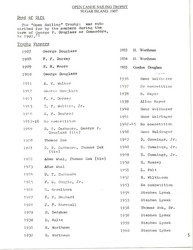
Sugar Island winners 1907-1960
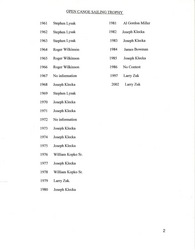
Sugar Island winners 1961-2002

Lady Bug winners 1907-1952
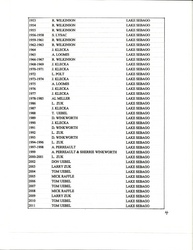
Lake Sebago winners 1953-2011
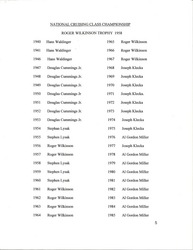
National Cruising Class 1940-1985

National Cruising Class 1986-2007
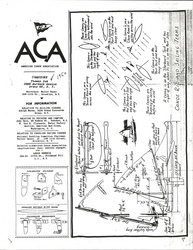
ACA Canoe rig and sailing terms
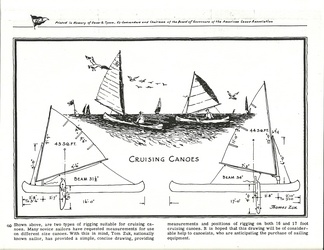
Cruising canoe measurements
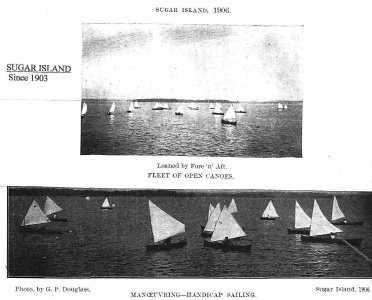
Sugar Island 1906
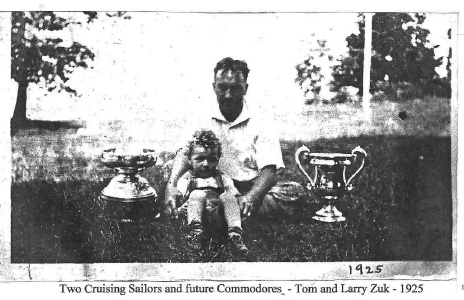
Tom and Larry Zuk 1925
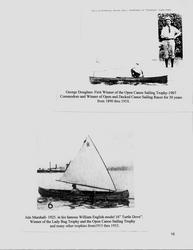
George Douglass and Jule Marshall
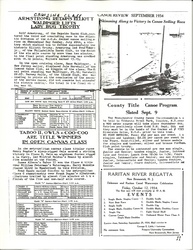
Armstrong retains Elliott Trophy
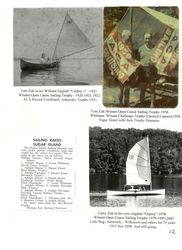
Tom and Larry Zuk winners

Sugar Island 2003 and 2006

Lake Sebago over the years
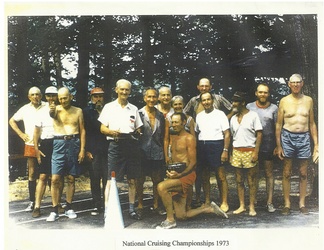
SAILORS AT 1973 NATIONAL CRUISING CLASS RACES - LAKE SEBAGO
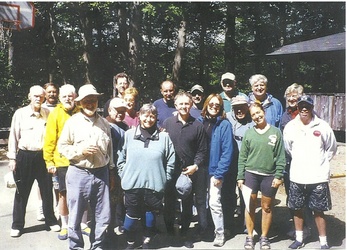
SAILORS AT THE 2006 CLASS-C AND ACA CLASS NATIONAL CHAMPIONSHIPS - LAKE SEBAGO

ATLANTIC DIVISION at
LAKE SEBAGO
Return to table of contents
 I have always been curious about the origins and history of the CRUISING CLASS of
sailing canoe. So now as we approach the hundredth anniversary of the two major trophies
for this kind of racing, I decided to investigate further. The first competitions for the
Cruising Trophy at the national level at Sugar Island and the Lady Bug Trophy at the
Atlantic Division Regatta were held in 1907 and have continued ever since. What happened
in 1907? What was going on in 1906? How had sailing the open canoe developed?
I have always been curious about the origins and history of the CRUISING CLASS of
sailing canoe. So now as we approach the hundredth anniversary of the two major trophies
for this kind of racing, I decided to investigate further. The first competitions for the
Cruising Trophy at the national level at Sugar Island and the Lady Bug Trophy at the
Atlantic Division Regatta were held in 1907 and have continued ever since. What happened
in 1907? What was going on in 1906? How had sailing the open canoe developed?


















